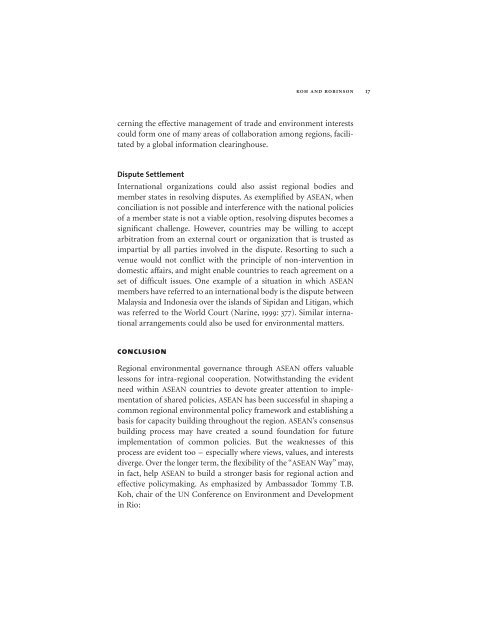Regional Environmental Governance: Examining ... - Yale University
Regional Environmental Governance: Examining ... - Yale University
Regional Environmental Governance: Examining ... - Yale University
You also want an ePaper? Increase the reach of your titles
YUMPU automatically turns print PDFs into web optimized ePapers that Google loves.
KOH AND ROBINSON 17<br />
cerning the effective management of trade and environment interests<br />
could form one of many areas of collaboration among regions, facilitated<br />
by a global information clearinghouse.<br />
Dispute Settlement<br />
International organizations could also assist regional bodies and<br />
member states in resolving disputes. As exemplified by ASEAN, when<br />
conciliation is not possible and interference with the national policies<br />
of a member state is not a viable option, resolving disputes becomes a<br />
significant challenge. However, countries may be willing to accept<br />
arbitration from an external court or organization that is trusted as<br />
impartial by all parties involved in the dispute. Resorting to such a<br />
venue would not conflict with the principle of non-intervention in<br />
domestic affairs, and might enable countries to reach agreement on a<br />
set of difficult issues. One example of a situation in which ASEAN<br />
members have referred to an international body is the dispute between<br />
Malaysia and Indonesia over the islands of Sipidan and Litigan, which<br />
was referred to the World Court (Narine, 1999: 377). Similar international<br />
arrangements could also be used for environmental matters.<br />
conclusion<br />
<strong>Regional</strong> environmental governance through ASEAN offers valuable<br />
lessons for intra-regional cooperation. Notwithstanding the evident<br />
need within ASEAN countries to devote greater attention to implementation<br />
of shared policies, ASEAN has been successful in shaping a<br />
common regional environmental policy framework and establishing a<br />
basis for capacity building throughout the region. ASEAN’s consensus<br />
building process may have created a sound foundation for future<br />
implementation of common policies. But the weaknesses of this<br />
process are evident too – especially where views, values, and interests<br />
diverge. Over the longer term, the flexibility of the “ASEAN Way” may,<br />
in fact, help ASEAN to build a stronger basis for regional action and<br />
effective policymaking. As emphasized by Ambassador Tommy T.B.<br />
Koh, chair of the UN Conference on Environment and Development<br />
in Rio:
















